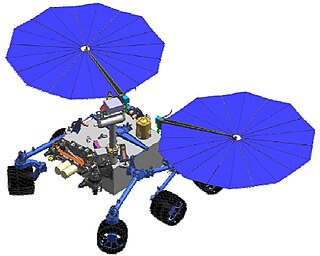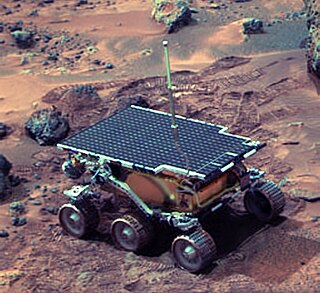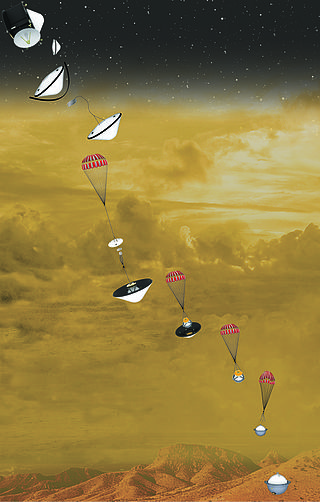
Mars Pathfinder is an American robotic spacecraft that landed a base station with a roving probe on Mars in 1997. It consisted of a lander, renamed the Carl Sagan Memorial Station, and a lightweight, 10.6 kg (23 lb) wheeled robotic Mars rover named Sojourner, the first rover to operate outside the Earth–Moon system.

A Mars rover is a motor vehicle designed to travel on the surface of Mars. Rovers have several advantages over stationary landers: they examine more territory, they can be directed to interesting features, they can place themselves in sunny positions to weather winter months, and they can advance the knowledge of how to perform very remote robotic vehicle control. They serve a different purpose than orbital spacecraft like Mars Reconnaissance Orbiter. A more recent development is the Mars helicopter.

Mars Science Laboratory (MSL) is a robotic space probe mission to Mars launched by NASA on November 26, 2011, which successfully landed Curiosity, a Mars rover, in Gale Crater on August 6, 2012. The overall objectives include investigating Mars' habitability, studying its climate and geology, and collecting data for a human mission to Mars. The rover carries a variety of scientific instruments designed by an international team.

The Astrobiology Field Laboratory (AFL) was a proposed NASA unmanned spacecraft that would have conducted a robotic search for life on Mars. This proposed mission, which was not funded, would have landed a rover on Mars in 2016 and explore a site for habitat. Examples of such sites are an active or extinct hydrothermal deposit, a dry lake or a specific polar site.
The embedded computer systems on board the Mars rovers sent by NASA must withstand the high radiation levels and large temperature changes in space. For this reason their computational resources are limited compared to systems commonly used on Earth.

The Mars Astrobiology Explorer-Cacher (MAX-C), also known as Mars 2018 mission was a NASA concept for a Mars rover mission, proposed to be launched in 2018 together with the European ExoMars rover. The MAX-C rover concept was cancelled in April 2011 due to budget cuts.

The Interior Exploration using Seismic Investigations, Geodesy and Heat Transport (InSight) mission was a robotic lander designed to study the deep interior of the planet Mars. It was manufactured by Lockheed Martin Space, was managed by NASA's Jet Propulsion Laboratory (JPL), and most of its scientific instruments were built by European agencies. The mission launched on 5 May 2018 at 11:05:01 UTC aboard an Atlas V-401 launch vehicle and successfully landed at Elysium Planitia on Mars on 26 November 2018 at 19:52:59 UTC. InSight was active on Mars for 1440 sols.

Curiosity is a car-sized Mars rover designed to explore the Gale crater on Mars as part of NASA's Mars Science Laboratory (MSL) mission. Curiosity was launched from Cape Canaveral (CCAFS) on November 26, 2011, at 15:02:00 UTC and landed on Aeolis Palus inside Gale crater on Mars on August 6, 2012, 05:17:57 UTC. The Bradbury Landing site was less than 2.4 km (1.5 mi) from the center of the rover's touchdown target after a 560 million km (350 million mi) journey.

Rover Environmental Monitoring Station (REMS) is a weather station on Mars for Curiosity rover contributed by Spain and Finland. REMS measures humidity, pressure, temperature, wind speeds, and ultraviolet radiation on Mars. This Spanish project is led by the Spanish Astrobiology Center and includes the Finnish Meteorological Institute as a partner, contributing pressure and humidity sensors.

Sojourner is a robotic Mars rover that landed in the Ares Vallis channel in the Chryse Planitia region of the Oxia Palus quadrangle on July 4, 1997. Sojourner was operational on Mars for 92 sols. It was the first wheeled vehicle to rove on a planet other than Earth and formed part of the Mars Pathfinder mission.

Mars 2020 is a Mars rover mission forming part of NASA's Mars Exploration Program that includes the rover Perseverance, the small robotic, coaxial helicopter Ingenuity, and associated delivery vehicles. Mars 2020 was launched from Earth on an Atlas V launch vehicle at 11:50:01 UTC on 30 July 2020, and confirmation of touch down in the Martian crater Jezero was received at 20:55 UTC on 18 February 2021. On 5 March 2021, NASA named the landing site of the rover Octavia E. Butler Landing. As of 22 December 2022, Perseverance and Ingenuity have been on Mars for 654 sols.

DAVINCI is a planned mission for an orbiter and atmospheric probe to the planet Venus. Together with the VERITAS mission, which will also study Venus, it was selected by NASA on 2 June 2021 to be part of their Discovery Program.

The ExoMars Kazachok was a planned robotic Mars lander led by Roscosmos, part of the ExoMars 2022 joint mission with the European Space Agency. Kazachok translates as "Little Cossack", and is also the name of a folk dance.

The Seismic Experiment for Interior Structure (SEIS) is a seismometer and the primary scientific instrument on board the InSight Mars lander launched on 5 May 2018 for a landing on 26 November 2018; the instrument was deployed to the surface of Mars on 19 December. SEIS is expected to provide seismic measurements of marsquakes, enabling researchers to develop 3D structure maps of the deep interior. Better understanding the internal structure of Mars will lead to better understanding of the Earth, Moon, and rocky planetary bodies in general.

The Mars Environmental Dynamics Analyzer (MEDA) is an instrument on board the Mars 2020 Perseverance rover that will characterize the dust size and morphology, as well as surface weather. Specifically, the information obtained will help address future human exploration objectives, as dust sizes and shapes, daily weather report and information on the radiation and wind patterns on Mars, that are critical for proper design of in situ resource utilization systems. MEDA is a follow-on project from REMS, of the Curiosity rover mission. MEDA has an increased scope, with greater data collection on Mars dust which contributes to overall Mars program objectives and discovery goals.

OCEANUS is a mission concept conceived in 2016 and presented in 2017 as a potential future contestant as a New Frontiers program mission to the planet Uranus. The concept was developed by the Astronautical engineering students of Purdue University during the 2017 NASA/JPL Planetary Science Summer School. OCEANUS is an orbiter, which would enable a detailed study of the structure of the planet's magnetosphere and interior structure that would not be possible with a flyby mission.

The Heat Flow and Physical Properties Package (HP3) is a science payload on board the InSight lander that features instruments to study the heat flow and other thermal properties of Mars. One of the instruments, a burrowing probe nicknamed "the mole", was designed to penetrate 5 m (16 ft) below Mars' surface. In March 2019, the mole burrowed a few centimeters, but then became unable to make progress due to various factors. In the following year further attempts were made to resolve the issues, with little net progress. On January 14, 2021, it was announced that efforts to drill into the martian surface using the device had been terminated.
ADRON-RM is a neutron spectrometer to search for subsurface water ice and hydrated minerals. This analyser is part of the science payload on board the European Space Agency'sRosalind Franklin rover, tasked to search for biosignatures and biomarkers on Mars. The rover is planned to be launched in August–October 2022 and land on Mars in spring 2023.
Spanish Astrobiology Center is a state-run institute in Spain dedicated to astrobiology research, and it is part of the National Institute of Aerospace Technology (INTA) as well as the Spanish National Research Council (CSIC). It was created in 1999 and it is affiliated with NASA Astrobiology Institute.

The Mars 2020 mission and its rover, Perseverance, and helicopter Ingenuity, were launched from Earth on 30 July 2020. On 15 February 2022, The New York Times reported an overview of Mars 2020 mission events since landing in Jezero crater on Mars in February 2021. As of December 23, 2022, Perseverance has been on the planet Mars for 655 sols.

















